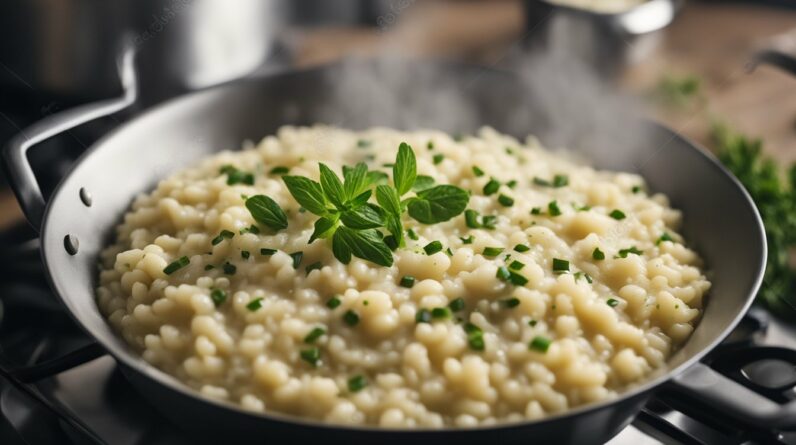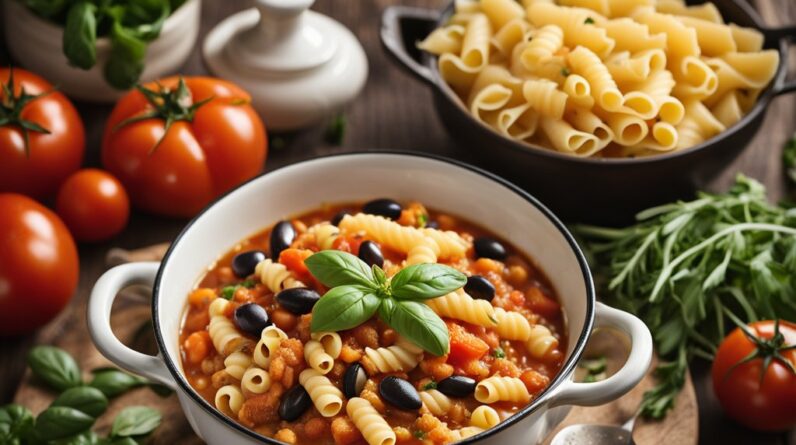Step into the vibrant world of Italian cuisine and discover the secrets behind how Italians prepare and savor the delightful flavors of fresh herbs like basil, parsley, and thyme. In this article, we’ll take you on a culinary journey as we explore the various techniques and recipes that Italians use to enhance their dishes with these aromatic herbs. Get ready to immerse yourself in the rich culinary traditions of Italy and unlock the secrets to making your meals burst with tantalizing herb-infused goodness.
Introduction
Italian cuisine and fresh herbs
Italian cuisine is renowned for its bold flavors and fresh ingredients. One of the key components that elevate Italian dishes to another level is the use of fresh herbs. Among these, basil, parsley, and thyme hold a special place in Italian cooking. These fragrant herbs not only add depth and complexity to recipes but also enhance the overall dining experience. Whether it’s a traditional pasta dish, a refreshing salad, or a comforting bowl of soup, fresh herbs play a vital role in bringing out the authentic flavors of Italian cuisine.
Importance of fresh herbs in Italian cooking
Fresh herbs are an essential ingredient in Italian cooking. They add a burst of freshness, aroma, and vibrant flavors to dishes. Italian cuisine places a strong emphasis on using seasonal, locally sourced ingredients, and fresh herbs perfectly align with this philosophy. Not only do they enhance the taste of a dish, but they also provide various health benefits. Rich in antioxidants, vitamins, and minerals, herbs like basil, parsley, and thyme are not only delicious but also contribute to overall well-being. So, let’s dive into the world of Italian herb cultivation, harvesting, and delectable recipes that celebrate the flavors of these fresh herbs.
Cultivating Fresh Herbs
Growing basil, parsley, and thyme in Italian gardens
Italian gardens have long been famous for cultivating a variety of herbs, including basil, parsley, and thyme. These herbs thrive in the Mediterranean climate, making Italy an ideal location for their cultivation. Many Italians take pride in growing their own herbs, whether it’s in a spacious backyard or a small balcony garden. The abundance of sunshine, along with well-drained and fertile soil, creates the perfect environment for these herbs to flourish and reach their full potential.
Ideal climate and soil conditions
Basil, parsley, and thyme prefer warm temperatures and require plenty of sunlight. They grow best in well-drained soil that has a slightly acidic to neutral pH. It’s important to ensure good air circulation around the plants and provide adequate spacing for them to grow. Additionally, herbs like basil and parsley grow well in containers, making them suitable for urban dwellers to cultivate even in limited spaces. With proper care and attention, anyone can have a thriving herb garden and enjoy the satisfaction of using fresh herbs in their Italian-inspired dishes.
Tips for successful herb cultivation
To ensure successful herb cultivation, here are a few tips to keep in mind:
- Start with healthy seedlings or high-quality seeds from a reputable source.
- Plant herbs in well-prepared soil or containers with good drainage.
- Water herbs regularly, but avoid overwatering, as herbs generally prefer a slightly drier environment.
- Trim or harvest the herbs regularly to promote continuous growth and prevent them from becoming woody.
- Protect the herbs from extreme weather conditions, such as excessive heat or frost, by providing shade or bringing them indoors if needed.
- Consider using organic fertilizers or natural compost to nourish the herbs without the use of harmful chemicals.
- Be mindful of any specific care requirements for each herb variety and adjust your cultivation practices accordingly.
By following these basic guidelines, you can enjoy a bountiful harvest of fresh herbs to elevate your Italian cuisine to new heights.
Harvesting Fresh Herbs
Best time to harvest basil, parsley, and thyme
Knowing the optimal time to harvest your fresh herbs is crucial to ensure the best flavor and fragrance. Basil should be harvested when the leaves are plump and vibrant green, just before the plant starts to flower. For parsley, the outer leaves can be picked as needed once the plant reaches a sufficient size. Thyme is best harvested just as the flowers begin to bloom, as this is when the flavor is most intense. By timing your harvest properly, you can maximize the taste and aroma of these herbs, enhancing the overall quality of your Italian dishes.
Harvesting techniques to maintain flavor and fragrance
To maintain the optimal flavor and fragrance of your freshly harvested herbs, follow these techniques:
- Use sharp, clean scissors or pruners to snip the stems just above a leaf node. This promotes new growth and prevents damage to the plant.
- Harvest in the morning when the essential oils in the herbs are at their peak. This ensures the best flavor and aroma.
- Avoid bruising or crushing the herbs excessively during harvesting, as this can result in flavor loss.
- Handle the herbs gently and avoid touching the leaves too much, as the oils and flavors can transfer to your hands.
- Discard any discolored or damaged leaves during the harvesting process to maintain the overall quality of the herbs.
By employing these techniques, you can preserve the full essence of your fresh herbs and create culinary masterpieces that truly capture the essence of Italian cuisine.
Storing fresh herbs for later use
If you have an abundance of fresh herbs, storing them properly is essential to avoid waste and ensure their continued freshness. Here are some methods for storing fresh basil, parsley, and thyme:
- Refrigeration: Place the freshly harvested herbs in a glass of water, cover them loosely with a plastic bag, and store them in the refrigerator. This method can keep the herbs fresh for up to a week.
- Freezing: Wash and dry the herbs thoroughly, then chop or mince them. Place them in an ice cube tray, cover with water or olive oil, and freeze. Once frozen, transfer the herb cubes to a freezer-safe container or bag. This method allows you to conveniently grab portions of herbs for future use.
- Drying: Tie the herb stems together with twine and hang them upside down in a well-ventilated area away from direct sunlight. Once dry, remove the leaves from the stems and store them in an airtight container. Dried herbs can be used for several months, but their flavor may differ slightly from fresh herbs.
By utilizing these storage methods, you can extend the lifespan of your fresh herbs and continue to enjoy their vibrant flavors long after harvest season.
Classic Italian Recipes
Caprese Salad with Fresh Basil
One of the most iconic Italian recipes featuring fresh basil is the classic Caprese Salad. This simple yet delicious dish combines juicy ripe tomatoes, creamy mozzarella, and aromatic basil leaves. The flavors of the ingredients complement each other perfectly, creating a refreshing and vibrant salad that captures the essence of Italian cuisine. Drizzled with extra virgin olive oil, sprinkled with salt and pepper, and perhaps accompanied by a balsamic glaze, the Caprese Salad is the epitome of simplicity and elegance.
Pesto Sauce with Basil and Pine nuts
Pesto sauce is another popular Italian recipe that highlights the flavors of fresh basil. Made by blending fresh basil leaves, pine nuts, garlic, Parmesan cheese, and olive oil, pesto is a versatile sauce that can elevate a wide range of dishes. Whether tossed with pasta, spread on bruschetta, or used as a marinade for grilled meats, the vibrant green color and aromatic taste of basil come together perfectly in this sauce. The combination of earthy pine nuts and fragrant basil creates a harmony of flavors that instantly transport you to the heart of Italy.
Italian Meatballs with Parsley
Parsley is a staple herb in Italian cuisine, and it shines in classic Italian meatballs. These savory delights are made with a mixture of ground meats, breadcrumbs, eggs, Parmesan cheese, and, of course, finely chopped fresh parsley. The parsley adds a fresh, herbal note to the meatballs, balancing the richness of the meat and enhancing the overall flavor. Paired with a tangy tomato sauce and served over spaghetti or in a crusty Italian roll, Italian meatballs with parsley are a true comfort food that brings warmth and satisfaction to every bite.
Minestrone Soup with Fresh Thyme
Thyme is an herb that adds a distinctive flavor to dishes, and it works wonders in a hearty bowl of Italian minestrone soup. This vegetable-based soup is packed with a medley of fresh vegetables, beans, and pasta, complemented by the aromatic essence of fresh thyme. The herb infuses the soup with a delightful herbal undertone, enhancing the overall complexity of flavors. From the first spoonful to the last, the marriage of thyme and the comforting flavors of the vegetables make minestrone soup a nourishing and soul-satisfying dish.
Preparation Techniques
Chopping and mincing herbs for flavor release
When using fresh herbs in Italian recipes, proper preparation techniques can significantly impact the flavor release. Chopping or mincing fresh herbs helps to release their essential oils, unlocking their full taste and aroma. For basil, stack the leaves, roll them tightly, and finely slice them to create delicate ribbons. Parsley can be finely chopped, ensuring the stems are discarded. Thyme leaves can be plucked from their stems and either minced or left whole, depending on the desired intensity of flavor. By taking a few extra moments to prepare the fresh herbs correctly, you can ensure that every bite is bursting with the vibrant flavors they have to offer.
Blanching basil leaves for vibrant color preservation
To preserve the vibrant green color of basil in certain recipes, blanching the leaves can be beneficial. Blanching involves briefly submerging the basil leaves in boiling water and then immediately transferring them to an ice bath to halt the cooking process. This technique helps retain the bright green color of the leaves and prevents them from turning brown or dull. Blanching is particularly useful for dishes like pesto, where the visual appeal of the basil is just as important as the flavor it imparts.
Using whole sprigs of parsley as a garnish
In many Italian recipes, parsley serves as both a flavoring agent and a decorative garnish. Using whole sprigs of parsley as a garnish adds a touch of elegance and freshness to the dish. Lay a few sprigs on top of pasta dishes, soups, or roasted meats before serving. This not only enhances the presentation but also allows diners to pluck the leaves as desired, adding an additional burst of flavor to each bite. The versatility of parsley makes it an excellent choice for both flavor and aesthetic appeal.
Infusing thyme into olive oil for aromatic essence
Another technique to extract the aromatic essence of thyme is infusing it into olive oil. This process involves gently heating the oil with thyme sprigs over low heat, allowing the flavors of the herb to infuse into the oil. This infused oil can be used to drizzle over salads, roasted vegetables, or even as a dip for crusty bread. The result is a fragrant and flavorful oil that incorporates the essence of thyme into any dish it is added to, bringing a touch of Italian sophistication to your culinary creations.
Traditional Italian Dishes
Insalata Caprese: A Fresh Basil and Tomato Salad
Insalata Caprese, also known as Caprese Salad, is a traditional Italian dish that showcases the delicate flavors of fresh basil and ripe tomatoes. The salad is composed of alternating slices of juicy tomatoes and creamy mozzarella cheese. Fragrant basil leaves are scattered in between the layers, adding a burst of freshness and aroma. Seasoned with a drizzle of extra virgin olive oil, a sprinkling of salt and pepper, and sometimes finished with a balsamic reduction, this salad encapsulates the essence of summer and the simplicity of Italian cuisine.
Pasta Aglio e Olio: Garlic and Parsley Pasta
Pasta Aglio e Olio is a classic Italian pasta dish that relies on the flavors of garlic and parsley to create a simple yet satisfying meal. The dish consists of spaghetti tossed with a sauce made from garlic sautéed in olive oil until golden brown. Finely chopped fresh parsley is then added to the sauce, infusing it with a vibrant herbaceous flavor. This quick and flavorful dish showcases the beauty of minimal ingredients and the way in which fresh herbs can elevate the most humble of dishes.
Chicken Cacciatore: A Hearty Dish with Thyme
Chicken Cacciatore is a hearty Italian stew filled with tender chicken, aromatic vegetables, and a rich tomato sauce. Thyme plays a crucial role in this dish, adding depth and complexity to the flavors. As the stew simmers, the thyme releases its essence, infusing the sauce with its aromatic qualities. The result is a robust and comforting dish that exemplifies the heartiness of Italian cuisine and the way in which herbs can transform a simple dish into something truly extraordinary.
Herbs in Italian Beverages
Basil-infused Lemonade: A Refreshing Summer Drink
When it comes to incorporating fresh herbs into Italian beverages, basil-infused lemonade is a quintessential choice. By steeping fresh basil leaves in homemade lemonade, you can create a refreshing and fragrant summer drink. The herbaceous notes of the basil perfectly complement the tartness of the lemon, resulting in a sweet, tangy, and herb-infused beverage that is both invigorating and thirst-quenching. Served over ice and garnished with a basil sprig, this drink is a delightful way to cool down on a hot summer day.
Parsley and Thyme Mojito: An Herbal Twist on a Classic Cocktail
For those looking to add an herbal twist to a classic cocktail, a parsley and thyme mojito is a perfect choice. This vibrant concoction incorporates muddled fresh parsley and thyme leaves, lime juice, sugar, and rum, creating a revitalizing herbal-infused cocktail. The combination of parsley’s fresh and grassy notes with thyme’s earthy undertones adds a unique dimension to the traditional mojito, making it a drink that will impress and surprise your guests.
Popular Herb Combinations
Basil and Parsley: A Classic Italian Duo
The combination of basil and parsley is a classic pairing in Italian cuisine, often used together in various recipes. Basil brings its signature sweet and slightly peppery flavor, while parsley adds a fresh and vibrant herbal note. Together, they create a harmonious duo that adds depth and complexity to dishes such as pasta sauces, soups, and salads. Whether it’s the comforting aroma of a homemade tomato sauce or the aromatic punch in a pesto, the combination of basil and parsley is a staple in Italian cooking that guarantees culinary success.
Parsley and Thyme: A Flavorful Pairing for Meat Dishes
Parsley and thyme are frequently paired together in Italian meat dishes, adding layers of flavor and enhancing the overall taste. Parsley offers a fresh, slightly peppery profile, while thyme brings an earthy and floral quality. The combination beautifully complements meats such as chicken, beef, or lamb, enriching their flavors and balancing their richness. Whether it’s marinating a roast, seasoning a grilled steak, or adding a finishing touch to a meat sauce, parsley and thyme blend harmoniously to create a well-rounded and delectable dining experience.
Basil, Parsley, and Thyme: The Holy Trinity of Italian Herbs
Together, basil, parsley, and thyme form the holy trinity of Italian herbs. Their distinctive flavors and aromatic qualities combine to create a symphony of tastes that epitomize Italian cuisine. Individually, they shine in specific dishes, but when used together, their flavors become elevated and well-rounded. The bright and sweet notes of basil, the fresh and herbaceous qualities of parsley, and the earthy and floral essence of thyme complement each other perfectly. Whether it’s a classic Caprese Salad, a comforting pasta dish, or a herb-infused sauce, this trio of herbs captures the very essence of Italian cooking.
Culinary Tips and Tricks
Substituting dried herbs for fresh in Italian recipes
While fresh herbs are preferred in Italian cuisine, there may be times when dried herbs are the only option. If you find yourself using dried herbs instead of fresh, it’s essential to adjust the quantity accordingly. As a general rule, you’ll need approximately one-third of the amount of dried herbs compared to fresh herbs. Dried herbs are more concentrated in flavor, so using them sparingly ensures that they don’t overpower the dish. Keep in mind that the texture and overall presentation may differ slightly when substituting dried herbs for fresh, but the flavors can still be delightful when used in the correct proportion.
Enhancing flavors with herb-infused oils and vinegars
Herb-infused oils and vinegars are a fantastic way to elevate the flavors of your Italian dishes. You can create your own herb-infused oils by infusing extra virgin olive oil with fresh herbs like basil, parsley, or thyme. Simply pour the oil into a jar, add the herbs, and let it sit for a few days to allow the flavors to meld. Herb-infused oils can be drizzled over salads, pasta dishes, or even used as a dip for crusty bread. Similarly, herb-infused vinegars can be made by adding fresh herbs to a bottle of high-quality vinegar and allowing them to infuse over time. These flavorful condiments add depth and complexity to your recipes, taking your Italian dishes to new heights of deliciousness.
Experimenting with different herb ratios for personalized dishes
Italian cuisine leaves plenty of room for creativity and personalization. While traditional recipes provide guidelines, feel free to experiment with different herb ratios to create your own unique dishes. Adjusting the amounts of basil, parsley, and thyme can alter the overall flavor profile of a recipe, allowing you to tailor it to your preferences. For those who love the aromatic essence of basil, increase the quantity to make it the star of the dish. If you lean towards the freshness of parsley, enhance its presence by adding a bit more to your recipes. Thyme can be used sparingly for a subtle touch, or generously to impart a more robust flavor. Play around with the ratios and find the blend that best suits your taste buds, ultimately making each dish a reflection of your culinary preferences.
Summing Up
The versatile use of fresh herbs in Italian cuisine
Fresh herbs are an essential component of Italian cuisine, bringing vibrant flavors and fragrant aromas to traditional dishes. Whether it’s the sweet and aromatic notes of basil, the fresh and herbal qualities of parsley, or the earthy and floral essence of thyme, these herbs have a distinct ability to elevate any recipe to new levels of culinary excellence. From cultivating and harvesting fresh herbs to exploring classic Italian recipes and experimenting with different flavor combinations, the world of Italian herbs is full of endless possibilities. Embrace the flavors of Italy and savor the taste of basil, parsley, and thyme as you immerse yourself in the rich heritage of Italian cuisine.









